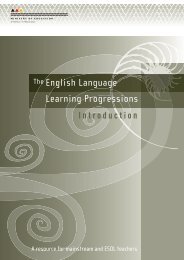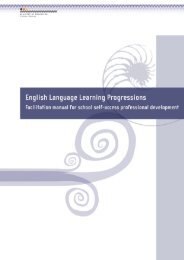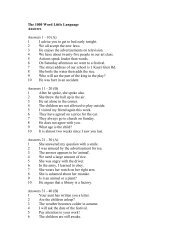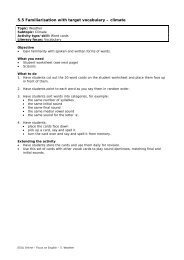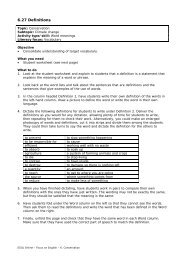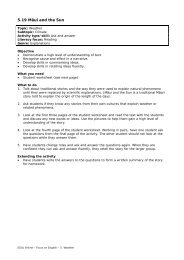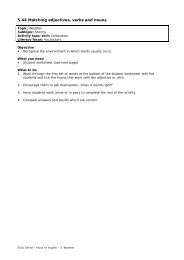DVD 2 facilitation notes (PDF 874KB) - ESOL - Literacy Online
DVD 2 facilitation notes (PDF 874KB) - ESOL - Literacy Online
DVD 2 facilitation notes (PDF 874KB) - ESOL - Literacy Online
You also want an ePaper? Increase the reach of your titles
YUMPU automatically turns print PDFs into web optimized ePapers that Google loves.
Making Language and Learning Work 2: Integrating language andlearning in secondary English and Social Sciences follows the2006 / 2007 Making Language and Learning Work 1: Integratinglanguage and learning in secondary Maths and Science. During 2008 athird <strong>DVD</strong>, with a primary focus, will be produced by the Ministry ofEducation.The materials support teachers to meet recommendations in anumber of documents which provide guidelines for teaching studentsfrom diverse language backgrounds in mainstream classes:• Quality Teaching for Diverse Students in Schooling: Best EvidenceSynthesis (Alton-Lee, 2003)• Improving English Language Outcomes for Students Receiving <strong>ESOL</strong>Services in New Zealand Schools with a Particular Focus on NewImmigrants (Franken and McComish, 2003)The materials also exemplify the application of the English LanguageIntensive Programme Years 7 to 13 (Ministry of Education, 2003) andEffective <strong>Literacy</strong> Strategies In Years 9 to 13 (Ministry ofEducation, 2004).The <strong>DVD</strong>s show how a range of teachers in different subject areasscaffold language and content area learning. The materials modelhow to personalise learning in a manageable way. Such materials areavailable overseas but this is the first comprehensive series of NewZealand materials.This set of <strong>notes</strong> supports on-going English and Social Sciences departmentor faculty-based professional learning. The <strong>DVD</strong> does notattempt to show all aspects of the lesson sequences, nor does it aimto provide step-by-step guidance in how to teach particular units in1
Overview of the <strong>notes</strong>1. A generic reflection template for use at alltimes when viewing and discussing. This covers:• What the teacher does• What the students do• Language and content focus• Links to The New Zealand Curriculum (suchas the Key Competencies, and AchievementObjectives in your learning area)2. Specific templates tailored to particularsequences that model the strategies/approaches used.3. Prompts the facilitator to other items ofinterest.4. Supplementary resources.Whenever you choose an approach or select a teaching/learningstrategy:• be clear about your purpose for using it;• explain to the students why they are using that strategy andwhat/how it will help them learn.Learning is much more likely to be retained and transferred tonew situations when this happens.5
Consider the Achievement Objectives, the Key Competencies andValues.What you would do differently? Why?Consider your context, your students.see also:• <strong>ESOL</strong> Resources for Schools, Teachers and School Communities(http://www.tki.org.nz/r/esol/<strong>PDF</strong>/<strong>ESOL</strong>_Pamphlet.pdf) andsee your <strong>ESOL</strong> teacher.• English <strong>Online</strong> (http://english.unitecnology.ac.nz/)Finding out about learners’ language and schoolingbackgroundsPrompt: What does the Afghan student say about what shefinds difficult in English?7
Hot PotatoFinding out learner’s prior knowledgehttp://www.tki.org.nz/r/esol/esolonline/classroom/teach_strats/hot_potato_e.phpQuestion to ask before viewing the Hot Potato strategy: How doyou find out what your learners know before beginning a unit ofwork?Generic template to observe the Hot Potato strategyPrompt: What reasons does the teacher give for circulatingaround the groups as they work?Using approaches that build on prior knowledgePrompt: Note how the teacher amplifies her languagewhen giving task instructions. (Try and visualise, tryand make a picture in your mind).8Prompt: What does the Afghan student say about thebenefit of using her first language (L1)? (Follows thelistening task - What I can see and What I can hear).
Generic templateInformation TransferMaking the lesson comprehensible to all learnershttp://www.tki.org.nz/r/esol/esolonline/classroom/teach_strats/info_transfer_e.phpGeneric templatePrompt: What does the student say about the benefit ofwall charts?Creative Clozehttp://www.tki.org.nz/r/esol/esolonline/classroom/teach_strats/creative_cloze_e.phpGeneric template11
Finding out about learners’ language andschooling backgroundsPrompt: What does the Mandarin speaker say is mostdifficult for her in English?Finding out learners’ prior knowledgeVocabulary Jumblehttp://www.tki.org.nz/r/esol/esolonline/classroom/teach_strats/voc_jumble_e.phpGeneric templateUse these words to practise a vocabulary jumble:lexical word, clusters, grammatical word, collocation, receptivevocabulary, modals, auxiliaries, nouns, phrasal verbs, adverbials, tense,active vocabulary, clines, productive vocabulary, frequency13
Using approaches that build on priorknowledgePrompt: What are some of the ways that diverse studentscan be used as an asset in the classroom?Giving learners many opportunities to first noticeand then use new languagePrompt: What is the purpose of using the words from thevocabulary jumble in a different task?5 Ws and an H14Recycling the use of the same language in differentwaysPrompt: What does the student say about the value ofreusing key words in different ways?
Listening RoundUsing approaches that include listening, reading, viewing,speaking, writing, and presentingGeneric templateReaching a Consensushttp://www.tki.org.nz/r/esol/esolonline/classroom/teach_strats/listening_round_e.phphttp://www.tki.org.nz/r/esol/esolonline/classroom/teach_strats/consensus_round_e.phpGeneric templatePrompt: How would you stop individual studentsdominating in group work?Prompt: What does the Mandarin speaker say about thevalue of having time before speaking?Prompt: What does the student say about the focus ontext structure?15
Planning the learning tasks so that all learners areactively involvedPrompt: What does the teacher say about the benefit ofgroup work?Shared Writinghttp://www.tki.org.nz/r/esol/esolonline/classroom/teach_strats/shared_writing_e.phpGeneric templatePrompt: What do the teacher and student say about thevalue of reflection at the end of a lesson?Prompt: If you have watched the whole of the Year 11sequence, reflect on how the tasks are sequencedto support the outcomes at the end.Other appropriate resources to support English languagelearners:Resources - English Language Intensive ProgrammeYears 7-13 Resource (ELIP). See Stage 3: Oral Language (4) andReading (9), for example.16
Story Graphhttp://www.tki.org.nz/r/esol/esolonline/classroom/teach_strats_graph_e.phpNew IdeasSetting the learning contextPrompt: What does the student say about the value of thestory graph?http://www.tki.org.nz/r/esol/esolonline/classroom/teach_strats/new_ideas_e.phpGeneric templateGiving learners many opportunities to first notice andthen use new languagePrompt: What do the students say about what helps themwork out word meanings in text?17
Reading Overview Grid(a type of advance organiser that clarifies a purpose forreading)What are the students doing?Why is the teacher using this approach?How does the teacher ensure all the students contributeequally?What would you do differently?How could you use an advance organiser at a different phasein the lesson sequence?How does this link with the Key Competencies in The NewZealand Curriculum (2007)?http://www.tki.org.nz/r/esol/esolonline/classroom/teach_strats/reading_overview_grid_e.phpSome other advance organisers:Anticipatory guides http://www.tki.org.nz/r/esol/esolonline/classroom/teach_strats/anticipatory_e.phpGraphic organisers http://www.tki.org.nz/r/esol/esolonline/classroom/teach_strats/graphic_organisers_e.phpDouble entry journal http://www.tki.org.nz/r/esol/esolonline/classroom/teach_strats/double_entry_journal_e.php18
Word ClustersPrompt: What do the students say about the value ofgroup work?http://www.tki.org.nz/r/esol/esolonline/classroom/teach_strats/word_clusters_e.phpGeneric templateRecycling the use of the same language in differentwaysDouble Entry JournalA double entry journal is usedhere for...If I had been the teacher Iwould have...The teacher says the value ofthe journal is...In my class I would use it for...19
http://www.tki.org.nz/r/esol/esolonline/classroom/teach_strats/double_entry_journal_e.phpGeneric templateUsing approaches that include listening, reading, viewing,speaking, writing, and presentingPrompt: What does the student say helps him learn?Mind Mirrorhttp://www.tki.org.nz/r/esol/esolonline/classroom/teach_strats/mind_mirror_e.phpGeneric template20
Co-operative ReadingPlanning the learning tasks so that all learners areactively involvedhttp://www.tki.org.nz/r/esol/esolonline/classroom/teach_strats/coop_read_e.phpGeneric templatePrompt: How are the question dice used in this task?(http://www.tki.org.nz/r/esol/esolonline/classroom/teach_strats/cube_e.php)Freeze FrameGeneric templateOther appropriate resources to support English languagelearners:English Language Intensive Programme Years 7-13 Resource (ELIP)See Stage 3: Reading (6) and Writing (12 and 14),for example.21
Finding out about learners’ language and schoolingbackgroundsPrompt: What does the student say about his role helpingnewly arrived students?Prompt: How does the teacher find out about thestudents’ Social Studies skills and knowledge?Prompt: What does the teacher say about integratedrather than withdrawal classes for <strong>ESOL</strong> students?Finding out learners’ prior knowledgePrompt: What does the teacher say about the importanceof having both a language and content focus?22Prompt: In what ways might the following tasks based onthe Pasifika high achievers text be expanded to include theethnicities of non-Pasifika students in the class?
Four Cornershttp://www.tki.org.nz/r/esol/esolonline/classroom/teach_strats/four_corners_e.phpGeneric templateSpeaking Framehttp://www.tki.org.nz/r/esol/esolonline/classroom/teach_strats/speaking_frames_e.phpGeneric templatePrompt: What do you notice about the students’ languagewhen they use the speaking frame? How would youextend your students with a speaking frame?Using approaches that build on prior knowledgeConcept Starhttp:// www.tki.org.nz/r/esol/esolonline/classroom/teach_strats/concept_star_e.phpGeneric template23
Making the lesson comprehensible to all learnersJigsaw Readinghttp://www.tki.org.nz/r/esol/esolonline/classroom/teach_strats/jigsaw_e.phpGeneric templatePrompt: The students use their mother tongues (L1). Whatconditions are needed in the classroom for this to happen?Prompt: How does the teacher provide support todifferent language speakers?Writing Framehttp://www.tki.org.nz/r/esol/esolonline/classroom/teach_strats/writing_frames_e.phpGeneric template25
Using approaches that include listening, reading, viewing,speaking, writing, and presentingListening RoundGeneric templateReaching a ConsensusGeneric templateCollaborative Posterhttp://www.tki.org.nz/r/esol/esolonline/classroom/teach_strats/listening_round_e.phphttp://www.tki.org.nz/r/esol/esolonline/classroom/teach_strats/consensus_round_e.phphttp://www.tki.org.nz/r/esol/esolonline/classroom/teach_strats/collaborative_posters_e.php26
Generic templateResources used in this sequencePasifika achievers text: http://english.unitecnology.ac.nz/nesb/resource_exchange/view_resource.php?res_num=13Other appropriate resources to support English language learners:Oral Language in the Introduction and Years 9-13 The EnglishLanguage Learning Progressions (ELLP)English Language Intensive Programme Years 7-13 Resource (ELIP)27
Finding out about learners’ language and schoolingbackgroundsPrompt: What does the Samoan student say about herlanguage background?Prompt: What does the Chinese student say about his useof dictionaries / friends?Finding out learners’ prior knowledgeGeneric template re how the teacher finds out priorknowledgeNote especially:28Prompt: What does the teacher say about having alanguage focus?• what the students say about using their prior knowledge andmaking links to knowledge in L1;
• what the teacher says about circulating around the room whilegroup work is happening.Split InformationUsing approaches that build on priorknowledgehttp://www.tki.org.nz/r/esol/esolonline/classroom/teach_strats/split_info_e.phpGeneric templateWriting DefinitionsPlanning the learning tasks so that all learners areactively involvedGeneric template29
Prompt: How does the teacher support the students indoing this?Prompt: How does the teacher build in reflection at theend of the lesson?Prompt: What is the role of the bilingual tutor? How wouldyou use a bilingual tutor?Prompt: What is the purpose of the quick activity theteacher does at the end of each lesson?Explanatory Notes:• We are learning to.... (Walt)• What I am looking for...... (Wilf)Verb StoryUsing approaches that include listening, reading, speaking,writing, viewing and presentinghttp://www.tki.org.nz/r/esol/esolonline/classroom/teach_strats/verb_story_e.php30
Generic templateThe teacher explains the process and writes the verbs on the board,with each verb on a new line. The students retell the process usingthe verbs as prompts. They then write down the process and comparetheir version with the original. The benefits are that studentsfocus while listening. They also notice and use correct verb formsand can use the verbs on the board as a scaffold for their writing.The students listen, read, speak, and write. This helps learners tofocus on forms of words.Picture MatchingGeneric templateWriting Frameshttp://www.tki.org.nz/r/esol/esolonline/classroom/teach_strats/picture_matching_e.phphttp://www.tki.org.nz/r/esol/esolonline/classroom/teach_strats/writing_frames_e.phpGeneric template31
Writing frames are…They give…In this case the focus is on…They are useful …or when there are only one or two English languagelearners in the classroom.Students themselves can choose…I would use writing frames when…Prompt: How could the student who asks “[What is] thatlong word, that ‘c’ word?” be supported more to learn theword well?Linking learning to real lifePrompt: What does the teacher say about how tosequence a lesson?Ask and AnswerGeneric template32Prompt: What does the student say about her role as anexpert?
SequencingSetting the learning contextSequencinghttp://www.tki.org.nz/r/esol/esolonline/classroom/starter_packs/strip_stories_e.phpGeneric templatePrompt: How does amplifying text (adding anotherexplanation) help English language learners?(harvested - picked)Say It!http://www.tki.org.nz/r/esol/esolonline/classroom/starter_packs/say_it_strategy_e.phpGeneric templateNote: In the Say It! the student talk is brief. Discuss waysthat you could assist students to extend their talk.33
(A1) You are the teacher -How might the student talk beextended?(A2 ) You are the teacher–Why did you use the Say It?(B1) You are a student – Wouldyou rather use a Say It! in asmall group or in the largeclass?(B2 ) You are yourself –In whatcontext could you use thistechnique in your classroom?Prompt: On reflection at the end of the sequence of tasks,what does the teacher say she would do another time?34
Resources used in this sequenceSee English Language Intensive Programme Years 7-13 Resource (ELIP),for different types of verb patterns (Stage 2: 3 Oral Language, recount,for example).Other appropriate resources to support English language learners:The Relationships Between Ideas and Common Patterns that Occur inText http://www.tki.org.nz/r/esol/esolonline/classroom/teach_strats/basic_text_patterns_e.phpFocus On English: English for Science 5 –Weather; English for Science6 - ConservationEnglish Language Intensive Programme Years 7-13 Resource (ELIP),Stage 2 Reading: 10 &19 (description), 14 & 20 (explanation); Stage3: 12 (description), 8 & 16 (explanation).35
Finding out about learners’ language and schoolingbackgroundsPrompt: What do the students say is difficult?Finding Out TableFinding out learner’s prior knowledgeGeneric templatePrompt: What does the teacher say is the value ofprior knowledge?Prompt: Why (says the student) is it important to makeconnections from English to the first language (L1)?36
Role Play CardsLinking learning to real lifeGeneric TemplateSplit InformationGiving learners many opportunities to first notice andthen use new languagehttp://www.tki.org.nz/r/esol/esolonline/classroom/teach_strats/split_info_e.phpGeneric templateGuided Writing(statement, explain, example, why it is important)Generic template37
Setting the learning contextListening Dictation (Title, axes, lines, label)Generic templateGiving learners many opportunities to first notice andthen use new languageBarrier Exercisehttp://www.tki.org.nz/r/esol/esolonline/classroom/teach_strats/listening_dictation_e.phphttp://www.tki.org.nz/r/esol/esolonline/classroom/starter_packs/barrier_games_e.phpGeneric template38
Using approaches that include listening, reading, speaking,writing, viewing and presentingThree Level Guidehttp://www.tki.org.nz/r/esol/esolonline/classroom/teach_strats/3levels/home_e.phpGeneric templateSetting the learning contextStructured Overviewhttp://www.tki.org.nz/r/esol/esolonline/classroom/teach_strats/structured_overviews_e.phpGeneric template39
Linking learning to real lifeConsensusGeneric templateResourcesLooking at the Relationships Between Ideas and Common Patterns thatOccur in Texthttp://www.tki.org.nz/r/esol/esolonline/classroom/teach_strats/consensus_round_e.phphttp://www.tki.org.nz/r/esol/esolonline/classroom/teach_strats/basic_text_patterns_e.phpOther resources which could be usedEnglish Language Intensive Programme Years 7-13 Resource (ELIP)40





